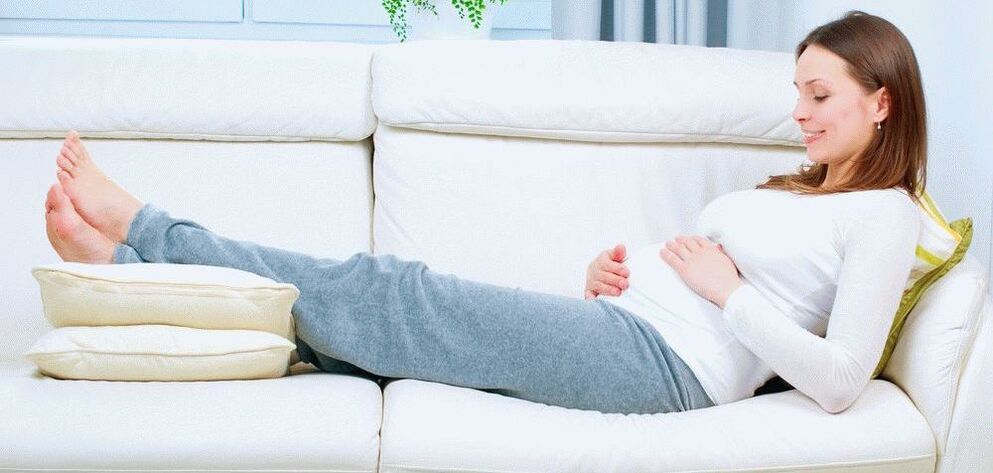
reason
development factors
- Lack of physical activity or a sedentary lifestyle.During pregnancy, especially in the last trimester, physical activity is inevitably limited. Sometimes, complete restriction of movement is key to preserving the fetus; the woman is forced to stay in bed most of the time. As a result, the veins of the lower limbs are damaged, blood wall tension decreases, and the blood and oxygen supply to the legs deteriorates. The result is the development of varicose veins.
- Increased load on the venous network.During pregnancy, women continue to gain weight. Blood pressure increases and veins become compressed. The expansion of the walls becomes permanent, which is fraught with irreversible pathological processes.
- Hormone levels change dramatically.During pregnancy, progesterone levels increase rapidly. This hormone is responsible for the normal course of pregnancy and the preservation of the fetus. But it can have a negative impact on the vascular system, causing the blood walls to stretch and blood to start overflowing.

- Rapid weight gain – This can happen if a woman doesn’t eat the right diet;
- The capillary network and spider veins are present before the child is conceived;
- multiple pregnancies;
- waxing;
- moving heavy objects;
- Prolonged exposure to direct sunlight.
symptom
- Severe swelling of lower limbs;
- Persistent itching and burning sensation in the affected area;
- Increased epidermal dryness;
- Pain, seizures, especially at night;
- Feeling heavy after physical activity, long walks, or even short walks;
- Ulcers appear on the skin and are difficult to remove.
logo
- Legs, ankles, and feet become swollen, swollen, and painful;
- Cramps and cramps in the buttocks and legs, especially at night;
- Heaviness in the lower limbs, especially in the afternoon;
- Increased itching, burning, and dry skin;
- Veins are clearly visible above the surface of the skin;
- Epidermal ulceration is difficult to treat and does not heal for a long time;
- If you lift your legs, the intensity of the pain will lessen.
- Pulling, aching discomfort and pain in the lower abdomen;
- Persistent pain during bowel movements;
- Burning sensation when emptying the bladder;
- Itching and stinging after emptying the bladder;
- In close relationships, unpleasant feelings can arise.
Varicose veins during pregnancy
first three months

second trimester
late pregnancy

diagnosis
- General urinalysis;
- clinical blood tests;
- Study of blood biochemical parameters;
- Ultrasonography;
- Duplex scanning;
- If necessary, magnetic resonance imaging may be performed.
treat

- Wear medical knitwear with compression properties.Shapewear, stockings, pantyhose and knee-high socks are recommended. Thanks to this knitting, blood vessels remain in proper shape, veins do not dilate and blood flow improves. Wear these products throughout the day and do not take off stockings at night if you have vein problems.
- Use appropriate shoes.Stilettos, platform shoes and high heels are prohibited. Wearing this kind of shoes frequently puts a heavy load on the muscles of the lower limbs, worsens the natural blood circulation, and causes fatigue soon. It is recommended to choose low-heeled shoes that are comfortable and stable.
- Quantifying physical activity.Varicose veins can become congested during pregnancy, so you need to eliminate them. For this, it is recommended to swim, walk more and perform special therapeutic exercises.
- Maintain a proper diet.To make the walls of blood vessels stronger, it is recommended to include in the menu foods rich in ascorbic acid, tocopherol, niacin and B vitamins. Products containing potassium, magnesium and manganese are also useful. The diet should contain foods high in fiber. They are a good way to prevent constipation.

- Lift your legs frequently;
- After a hard day at work, soak your feet in warm water with dissolved sea salt for half an hour;
- Do not cross your legs to avoid disrupting blood circulation;
- Change positions frequently and warm up regularly;
- sleep on left side;
- Control intake of salty foods;
- Weight control.


















